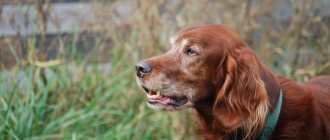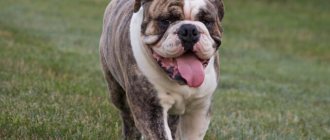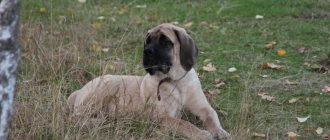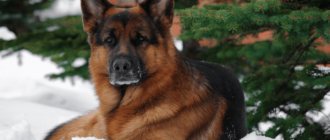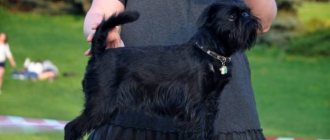The English Setter is a friendly and cheerful companion. This graceful, long-haired dog with an attractive appearance was bred for hunting. But the breed is also popular among ordinary dog breeders. Despite the developed hunting instincts, the setter can be kept in a city apartment. This is a smart, affectionate and sociable pet. But before getting an English Setter, you need to study the description of the breed, the pros and cons, and reviews from the owners.
- Head
- Features of education and training
- Nutrition
History of the English Setter breed
English Setter
The origins of the English Setter are controversial and cause lively debate among breeders. Some attribute the role of the ancestors of the breed to the “Spaniards”, others to the ancestors of modern spaniels. The true roots of setters are unknown. The only undeniable fact is that this is an English breed, no matter who its distant ancestors were.
Recently, dog breeders are increasingly leaning towards the second version. During the Renaissance, spaniels were extremely popular in Western Europe. At that time, there were two main types of this breed: for hunting in wetlands (“water”) and on land (“field”). The most famous at that time was the setting spaniel. Representatives of this breed were guided by a unique way of hunting birds. Noticing her, the dog would sneak up and take a stance, thereby attracting attention. The hunter carefully approached the prey and threw a net over it: firearms appeared much later.
The behavior of the animal during the hunt determined the name of the future breed. The word comes from the English set - to install. Indeed: having noticed the prey, the dog indicated its location to the owner using a conditioned signal - a stance. Sometimes the name "setter" is mistakenly translated as "crouching". Despite this, the version has a right to exist: during a hunt, the animal actually “crouches” to the ground in order to quietly approach the game.
Initially, the selection of setters was focused solely on preserving the working qualities of dogs. The exterior did not arouse interest and therefore was extremely diverse - exactly like the breeds with which the setting spaniels were crossed: retrievers, greyhounds, hounds and even poodles. The resulting specimens were quite varied, but this did not detract from their hunting qualities.
The appearance of setters attracted dog breeders only in the first half of the 19th century. It was then that an interesting feature was discovered: despite the fact that all the dogs belonged to the same breed, their color varied strictly depending on the territory. Scotland “homed” black and tan setters; Ireland - animals of red-piebald and chestnut-red colors; southern part of England - white dogs with orange, black or brown markings.
This pattern prompted breeders to identify three independent branches: Scottish (Gordon Setters), Irish (Red Setters) and English (appropriately named). Edward Laverack took up work on the exterior of the last branch. He was a passionate hunter - it was this trait that attracted attention to setters.
Sir Laverack began his selection work with two specimens purchased from Pastor Harrison - Old Mall and Ponto. The breeder planned to improve the breed through inbreeding - crossing animals that were related. He put his soul into fifty years of selection, which bore fruit - the graceful and elegant exterior of the English Setter.
Sir Edward's cause was also supported by his compatriot Richard Llewellyn. Unlike his colleague, the breeder did not adhere to the strategy of inbreeding, considering it necessary to dilute the setter gene pool with other breeds. This caused a conflict, because of which the British continued to work on breeding dogs, but independently of each other. This is how two branches of the breed were formed: the Laverack and Llewellyn lines.
In 1859, English setters first appeared at an exhibition in Newcastle upon Tyne. The more often representatives of the breed participated in such shows, the more their popularity grew. The turning point in the history of setters was the 70s of the 19th century. The English Kennel Club recognized the breed and began keeping its pedigree book. At the same time, the first dogs set foot on the lands of the New World, causing another wave of popularization of setters. Ten years later, the American Kennel Club officially recognized the four-legged English aristocrats, who eventually formed a new line of the breed - this time American.
In Russia, the dogs were known as Laverack Setters. They were often called “loviraks” - in the Russian manner; making fun of the fact that the animals refuse to catch crayfish, but they do an excellent job of hunting birds. The dogs were popular with aristocrats who kept huge kennels. Historical facts confirm: the setter was one of the favorite breeds of Nicholas II. These animals were also preferred by many representatives of the intelligentsia: Alexander Kuprin, Ivan Bunin and Alexander Blok. The revolution of 1917 almost put an end to the development of the breed. It found its second wind only at the end of the 20th century.
English Setters remain popular. Due to many years of selection and separation of the show class, the dogs' hunting instincts have become slightly dulled. The laurels of the winner passed on to other breeds (in particular, the Breton Epagnole). Despite this, “English dogs” are still used as gun dogs, but more and more often they are found as friendly and active companions who can brighten up the most monotonous everyday life.
Kinds
There are several classic types of setters:
- Irish.
- Scottish.
- Gordon.
- English.
Each of them has a specific hunting talent and coat color. The Irish Setter has no varieties. The breed has a standard that is generally recognized. The main indicator of a purebred dog is bright red fur, less often chestnut. If an animal has white-red or black spots on its body, it is probably another type of setter.
Appearance of the English Setter
The English Setter is a medium-sized breed. These dogs have clearly visible sexual dimorphism: females look more graceful and sophisticated than males. However, in both cases, setters are distinguished by their proportional and lean physique.
The breed standard determines the parameters of animals. Thus, the height of a male dog at the withers reaches 65-68 cm, that of a female dog – 61-65 cm. The weight of an English Setter is 25-36 kg and 20-32 kg, respectively. Males are heavier and more massive.
Head and skull
English Setter in the forest
The light head of the English Setter is of moderate length, carried high and proud. In profile, parallel lines of the forehead and lower jaw are visible. The oval-shaped skull has a pronounced occipital protuberance and a wide frontal part - they provide enough space for the brain. The brow ridges give the dog's head a relief, protruding slightly forward.
Muzzle
When looking at the animal's head from above, it becomes noticeable that the straight muzzle is narrower in comparison with the skull. Moreover, its length coincides with the length from the stop to the back of the head (square type). Under eyes are well filled. The transition from forehead to nose with a straight back is clear. The setter's flat cheeks hardly stand out. The movable nose has wide nostrils - the main advantage of a hunting dog - and is pigmented in a black or brown shade. The lips fit tightly to the jaws, with the upper one slightly hanging over the lower one. Folds form in the corners of the mouth, but the mucous membrane is not exposed. The color of the lip edging matches the color.
Ears
The English Setter's ears are set at eye level and point slightly towards the back of the dog's head. Soft and velvety to the touch, thin and narrow. The shape is close to triangular; The tips adjacent to the cheekbones are rounded. Covered with long hair.
Eyes
The eyes are set deep and quite far from each other. Oval shaped, small. The eyelids are dry and tight fitting. The cut is straight. The iris is colored brown (dark shades are preferred). At the same time, mottled setters have lighter eye pigmentation. The look is smart and expressive.
Jaws and teeth
Hunting dog breeds are distinguished by powerful jaws – and the English Setter is no exception. A uniform scissor bite is preferred. Its straight format is not considered a defect in animals over six years of age. Strong teeth have a healthy white color. The incisors are located at the same level, the fangs are clearly defined. The full formula is 42 teeth.
Neck
The flexible neck widens towards the shoulders and is set quite high. Its oval cross-section is noticeable when looking at the dog from the front. There is no dewlap, the nape is convex.
English Setter muzzle
Frame
The body of the animal is perfectly balanced, so it seems elegant and light. A strong back is distinguished by smooth curves in the area of the shoulder blades and croup. The chest is dry, the muscles acquire clear outlines in older dogs (three years and older). The ribs are convex and elongated, especially at the back, making the setter's chest appear full. The straight and short back develops into a moderately arched loin. The croup is sloping, with smooth outlines. The bottom line is smoothed, the stomach is adjusted in moderation.
Tail
English Setter with a child
The tail of the English Setter is set slightly below the line of the back, thereby continuing it. It is characterized by medium length, as well as a straight or saber shape. Tapers from base to tip. When calm, the dog keeps its tail lowered; when excited, it raises it almost parallel to the ground. The wavy hair at the bottom of the tail gives it a feather-like appearance.
Forelegs
The humerus bones are articulated at right angles with the shoulder blades retracted. There is practically no gap between the elbows and the chest of the setter. Oval forearms smoothly turn into pasterns of insignificant length. The fingers are gathered into a “ball” and end in strong claws. The developed paw pads are rough to the touch.
Hind limbs
When standing, they are directed backwards. The beautifully muscled legs are elongated. The wide hips are articulated with the croup at an angle of 90°; the lower legs are muscular. The joints of the limbs are dry. Short metatarsals lead into rounded paws with moderately convex pads. The space between the toes is filled with hair, which can be trimmed before participating in exhibition shows.
Movement style
English Setters are characterized by graceful and easy movements with a strong push of the hind legs. The dog maintains a proud posture, while holding its head high. The forelimbs are carried far forward when trotting. By increasing speed and pace, the animal places its paws closer to the midline.
Coat
The breed is characterized by “fouling” with a luxurious fur coat by the age of two or three years. The length of the hairs varies depending on their location. The head and front surfaces of the limbs are covered with short hair, which is slightly elongated throughout the dog’s body. In the area of the ears, chest, limbs and tail, thicker and longer hairs form fringes, “panties” and “feathers” on the tail.
Color
Lemon English Setter
To define the speckled color of a setter, the word “belton” is traditionally used, adding a prefix to it and thereby specifying the color:
- brown – liver;
- orange – orange;
- lemon - lemon;
- black - blue.
There is also a three-color version - brown or black speckled with tan. The breed requires a uniform distribution of markings without large spots.
Possible defects
Even the slightest deviation from the standard is considered a defect. Among the main ones are:
- excessively wavy and ring-shaped coat;
- high set ears, their uncharacteristic size;
- roundness of the skull in the area between the ears;
- excessively short or long tail;
- slanted and/or wide-set eyes;
- a sharp and short muzzle with jowls;
- flat or barrel chest;
- light pigmentation of the iris;
- straight shoulders and/or pasterns;
- sickle-shaped tail;
- narrow and hunchbacked back;
- underdeveloped croup.
English setter at a dog show
Disqualifying faults of the English Setter include:
- solid red, brown or black color without specks;
- sagging and excessively hunchbacked back;
- aggressive or fearful behavior;
- thick, round and short neck;
- ambling or heavy movements;
- wedge-shaped head;
- presence of dewclaws;
- yellow pigmentation of the eyes;
- narrow set of limbs;
- weak stop;
- hook-shaped tail;
- cryptorchidism;
- clubfoot.
Photo of English Setter
Character of the English Setter
Owners of English Setters note: this is one of the friendliest and most affectionate hunting breeds. Animals are human-oriented—sometimes too much so. Instead of a long sleep on his favorite bedding, the setter will prefer to spin under his feet, making himself known by periodically barking and taking all possible part in the owner’s activities. It doesn’t matter whether you are planning a trip to the store or watching television, a dog will always be pleasant company.
English setter jogging with owner
The hyper-sociability of the “English” is the main reason why animals suffer from loneliness and constantly experience fear of separation. To maintain a healthy and balanced psyche of your pet, it is not recommended to leave it unattended for the whole day. Setters love to spend time in the company of their owner and treat guests in the house with no less happiness. An animal can easily jump on your chest and “kiss” you, which not everyone will be happy about.
It follows from this that the breed is not suitable for home guarding. The dog sees every stranger as a potential friend and does not seek to defend the entrusted territory. However, with proper training, you can make an English Setter moderately friendly, but do not expect your pet to jealously guard property. To do this, it is better to choose another breed - a Giant Schnauzer, an Airedale Terrier or a larger Cane Corso.
The Setter's non-conflict nature and good nature make him an excellent dog for families with children. In games with little friends, the pet will show gentleness and patience, will not bare its fangs in response to a careless poke, and will happily get involved in children's adventures. This kind of company is the best for an active and sociable dog. However, you should not leave her alone with a small child: the pet may not calculate its strength and accidentally push your child during play.
Setter meets kitten
English Setters get along well with other pets. This breed is not prone to displaying jealousy, dominance and the desire to defend its rights to territory. On the contrary, your pet will be glad to have a four-legged brother who will help brighten up the loneliness in your absence. The “Englishman” needs an equally energetic and temperamental friend who will not be horrified by the indomitable energy and will support any adventure - be it hunting for a fly or chasing a sunny “bunny”.
With proper socialization, the setter lives in the same territory with small pets. A dog playing with decorative rodents and birds can have sad consequences, but only by accident. Otherwise, the instincts of the “Englishman” do not include the pursuit of prey, because the task of the setter is to indicate the location of the game with the help of a stance, and not to catch it.
This breed is divided into two lines - working and show, but both need active walks. At the same time, show-category dogs can be content with long promenades and the opportunity to run around in the fresh air. It is advisable to keep working dogs in a private house with a spacious fenced yard: these pets can drive even the most trained athletes half to death.
It is logical to assume that the working line of English Setters is not suitable for keeping in an apartment. Lack of exercise will make your dog uncontrollable. In an attempt to throw out the accumulated energy, your pet can cause real mayhem in your absence, so get ready for an unpleasant surprise.
As for exhibition specimens, they are quite comfortable living in apartments. Moreover: after a walk, the setter magically transforms into a couch potato and spends the rest of the day on the sofa next to its owner.
As befits a hunting dog, the “Englishman” loves hunting so much that he is ready to sacrifice food and sleep for the opportunity to follow his instincts and find prey in the tall grass. The setter's flair and excellent tracking skills make it a versatile gundog, whose talent is recognized by hunters from different parts of the world.
Running English Setter
Basic moments
- Representatives of the breed are known for their endurance, which will appeal to active owners. If they are not interested in hunting, then playing sports together with a four-legged partner will be a worthy replacement.
- The elegant appearance of the English Setter also deserves attention. The pet’s beautiful coat, combined with its grace and aristocracy, attracts everyone’s attention.
- Among the advantages of the breed are well-developed intelligence and quick wit. This trait is especially valued by hunting fans and dog breeders who train future champions.
- The pet will not nap throughout the day. He is not characterized by laziness; sitting in one place for a long time is an almost impossible task. But, despite all their energy, setters behave in an extremely well-mannered manner. They will not pester the owner and impose their company if they see that he is busy.
- Setters are far from the only breed that analyzes human behavior and is capable of providing support, but it is in them that these talents are especially strongly developed. They are also very sociable, which will appeal to the rest of the household, because the dog has both the energy and the desire to spend time with each of them.
- The pet has developed hunting instincts, but they are used only when catching prey. At home, they are cheerful, good-natured and do not show aggression towards strangers or other animals.
- It doesn’t matter whether the owner lives alone or with his family, he won’t be bored. Setters are not inclined to distance themselves from their household members and are happy to take part in everything that happens in the apartment.
- The list of advantages of individuals of this breed cannot include working as a watchman. The dog is not suitable for attentive “vigilance”, and it would rather “kiss” a stranger than prevent him from entering the territory.
- The pet will not only participate in all kinds of children's games, but will also look after the kids, and therefore will fit perfectly into a family with small children.
- Setters do not strive to take a dominant position and compete for the owner’s attention, and therefore get along well in the same territory with cats or other pets.
- Living conditions for the animal should be chosen based on its line. An exhibition dog will feel comfortable in an apartment, but a working dog needs a lot of space and the opportunity to stretch its paws.
- Training English Setters is not an easy task. Although dogs are highly intelligent, they also have a stubborn streak that makes them difficult to handle.
- Beginning dog owners may be intimidated by the need for meticulous daily grooming.
Education and training
English setter puppy on a leash
Representatives of the breed are characterized as very trainable and obedient animals, but they still cannot do without difficulties. Due to his stormy temperament, the “Englishman” may seem disobedient, so the owner will have to make efforts to educate and train, not forgetting to first stock up on iron patience.
Choosing a setter as a pet implies a strict hierarchy in the family. The puppy must understand that only one person is involved in feeding and raising him - his owner, who must be obeyed. Make consistent and firm demands on your pet: otherwise the animal will not understand what reaction you expect from it. At the same time, you should not go to extremes: raise your voice at the dog or, on the contrary, be touched by his every prank.
Set rules that the puppy should not go beyond. It is necessary to adhere to unanimity in raising a setter. If one family member scolds the baby for spoiled slippers, and the other praises him and secretly treats him with treats, the animal will never grow up obedient.
English setters have a developed intelligence, which allows them to learn most commands in the shortest possible time. The main thing is not to expect unquestioning obedience from your pet: this breed is not as obedient as an Aussie or a border collie. If the setter doesn't like your command, it will be difficult to force the pet to do what you want. At the same time, some representatives of the breed are afraid of upsetting the owner and would prefer to remain inactive rather than perform a command poorly.
Young setters tend to get carried away with the game and do not always listen to your words. You will have to take care to establish contact with your pet. The next step is to unobtrusively and gently return the “Englishman’s” attention to the training process. Imagine that there is a small child in front of you, to whom you cannot raise your voice, and act. This breed has a small amount of stubbornness, so it is worth learning to get the better of it.
English setters love to catch frisbees, run and catch the ball thrown by their owner. If you want to keep your pet busy with something more exciting, pay attention to obstacle racing or obedience.
Application
Initially, the animals were used as gun dogs. But today they are more often taken as companions.
If you need a friend, not a hunter, you should take a show line dog. She doesn't need to run for 12 hours to burn off energy. She is calmer, looks more beautiful, and can sublimate hunting with stances on pigeons and other urban birds.
If you want to hunt game, then you need to buy a dog from hunter breeders. They raise excellent working dogs.
Due to the lack of aggression, there are no watchmen or guards from pets. They would rather kiss a robber than bark at him.
Care and maintenance
An English Setter plays with a ball.
An English Setter needs daily and careful grooming. The reason for this is the long and thick coat, the main source of pride of the breed. These dogs shed profusely, which is especially noticeable among owners of white pets. Before purchasing an “Englishman”, make sure that your family members do not suffer from allergies to wool. Be prepared for the fact that regular wet cleaning will become an integral part of life once the setter appears.
The animal's fur needs daily thorough combing. Use a comb or brush with natural bristles: in addition to removing dead hair and dust, this device will provide your pet with a pleasant massage. When combing your setter, pay special attention to the long hair on the dog's paws and tail: this is where tangles most often form.
Trimming the coat will not be superfluous. In this case, it is recommended to contact a specialist rather than setting up a beauty salon at home. Representatives of the show line of setters need this procedure every five to six weeks, while the working line needs this procedure much more often.
The English Setter's coat is covered with a thin coat of fat, which protects the hairs from dirt and serves as a water-repellent barrier. You should not bathe your pet regularly: even mild shampoos for dogs can “wash out” the natural defenses. It is enough to give your setter baths once every ten days or as needed. When going for a walk in autumn or winter, it is recommended to dress your animal in waterproof overalls.
A dog's long, floppy ears accumulate fat and dirt, which can cause otitis media, which eventually develops into chronic otitis media. Clean your Englishman’s ears at least once a week using a cotton pad. As an auxiliary agent, you can use boric acid or another substance with a drying effect.
Rinsing the setter's eyes is an equally mandatory procedure, and it is best to use brewed tea. In extreme cases, running water will do. If your eyes are watery, inspect them carefully and rinse thoroughly if foreign particles are found.
Despite their excessive activity, English Setters rarely wear down their nails sufficiently. The reason lies in the fact that animals prefer to run on the ground rather than on asphalt. As the claws grow, they can become uncomfortable and cause your pet to limp. Use a nail clipper for large breed dogs and trim the nails once a month. A file will help smooth out sharp edges and nicks.
Beautiful, even though she got dirty
The oral cavity of the “Englishman” is no less demanding in care. The setter's teeth are cleaned using a special finger brush using dog toothpaste. Never share your personal hygiene products with your pet! Substances contained in “human” toothpaste can cause an allergic reaction and even poisoning.
English Setters are susceptible to drafts. Take care to equip a cozy corner, protected from any wind. A soft bed or a small children's orthopedic mattress is perfect.
Speaking about dog nutrition, it is worth noting: setters are not prone to obesity, since they instinctively limit themselves in food. By determining the exact portion size, you will never have difficulty feeding your pet. If the animal has emptied the bowl and continues to lick it, it means that it is still feeling hungry. Don’t be afraid to give out an extra portion: the setter will never gobble up food out of greed, as if he really was an English aristocrat. The best option for feeding your pet is a competent combination of natural food and premium brand food.
The English Setter needs a lot of protein, so be sure to include meat and boneless sea fish in its diet. Both products must be served raw, first scalded with boiling water and cut into pieces. Combine meat with rice and buckwheat porridge; Don’t forget to treat your pet to vegetables and fruits. It is recommended to give your setter fermented milk products for breakfast.
When choosing elite food, pay attention to options with a complete absence of vegetable proteins, preservatives and dyes. They are also good because they contain the vitamin and mineral complex necessary for the animal to maintain good health. If you prefer to feed your dog mostly dry food, be sure to provide 24-hour access to clean water. Bottled or pre-settled for 6-8 hours is best.
Eliminate the following foods from your English Setter's diet:
- milk (relevant for dogs over 4 months of age);
- fatty meat (in particular pork);
- tubular bones of any size;
- boiled and raw river fish;
- chocolate and other sweets;
- raw yeast dough;
- mushrooms in any form;
- berries with seeds;
- legumes;
- raw eggs.
Oh yeah... Carry on
My master is the best
Nutrition
First of all, his health depends on the organization of the dog’s menu. If the dog is weak, lethargic or not playful enough, this may indicate insufficient intake of microelements.
In order for the Irish Setter to fully perform its hunting function, it must consume at least 700 grams of food rich in vitamins and carbohydrates daily (adult). Puppies should be fed frequently, namely 4-5 times a day. You should not allow them to eat before bed, as this will make it difficult for them to fall asleep.
The main food that a large breed dog should eat is raw chicken or beef. It is advisable to give him 200-300 grams of this product every morning. In the first half of the day, he should consume a large amount of carbohydrates, which his body will process into energy. Beagle dogs especially need calories, as they are characterized by mobility.
In addition to beef/rabbit/chicken, give your setter cottage cheese and cereals. You can boil buckwheat, rice, millet, but not barley, as it is difficult to digest. But treating your four-legged friend with sweets, such as chocolate or cream cookies, is strictly not recommended. Eating confectionery products can cause gastritis in a dog. We recommend feeding dry food to an adult dog.
English Setter Health and Diseases
English Setter swimming in a pond
The excellent health of the representatives of the breed is due to the fact that breeders have always selected the strongest dogs without hereditary defects for breeding. Despite this, English setters are still susceptible to some diseases:
- congenital dilatation of the esophagus;
- purulent inflammation of the uterus;
- hip dysplasia;
- bone tumors;
- paralysis of limbs;
- congenital deafness;
- food allergies;
- retinal atrophy;
- volvulus;
- eversion of the eyelid;
- dermatitis;
- epilepsy;
- otitis
Otherwise, “English” dogs are considered dogs with good immunity, which is able to resist most common diseases.
How to choose a puppy
English setter puppy with unformed spots
You can get a purebred English Setter only in specialized nurseries or from a breeder who breeds the breed. In an attempt to save money, many often purchase a puppy secondhand or at the poultry market, and this is wrong. The miser pays twice, and in the case of a setter, you can get a pet with deviations from the standard or a bunch of hereditary diseases.
English Setter puppies are born without markings, which begin to appear and intensify with age.
There is no need to rush into choosing a puppy from the kennel either. Ask the breeder to show you the four-legged pair that produced the litter, and observe all the puppies. Try to determine whether among them there are defective babies: deaf, blind, with obvious defects of the breed. If such puppies are present, do not bother to check whether the breeder can show photographs of grown setters from the previous litter. This way you can determine how “standard” and healthy the pet is waiting for you.
How to choose one baby among all the charming crowd? Make a selection (desired gender, color and degree of compliance with the breed standard) and observe the puppies. Evaluate the setter's behavior in general, its manner of play and even its gait. A healthy baby should be active and moderately curious.
Mating
Males and females are untied from the age of 2 years. Until this age, they are not fully formed and remain puppies.
The first heat in female dogs occurs at 6, 12 or 14 months. But they start breeding her on the third or fourth heat.
Estrus lasts 20–22 days. The ideal mating period is 11-15 days.
Females bear puppies for up to 65 days. Pregnant bitches increase the caloric intake of their diet and make sure that they do not leak. It is not recommended to wash the expectant mother. Jumping, going up and down stairs, and swimming in bodies of water are also prohibited.
Photos of English Setter puppies
How much does an English Setter cost?
The price of representatives of the hunting breed is very arbitrary, since it depends on many factors: the title of the parents (if this is an exhibition specimen), the popularity of the kennel and its geographical location, the age and sex of the dog, and the animal’s compliance with the standard.
On average, English Setter puppies cost their future owners 25,000 - 30,000 rubles. For elite show-class dogs - potential exhibition winners - breeders can demand 70,000 - 80,000 rubles. Please note: when purchasing an English Setter from a kennel, you will receive a veterinary passport for the puppy with notes on vaccination and deworming treatment. The breeder also provides confirmation of the baby’s pedigree if this is important.
It does not matter which line the dog belongs to - working or show. In any case, you will get a playful and loyal friend who will brighten up your life!
